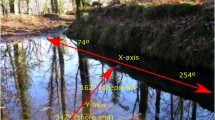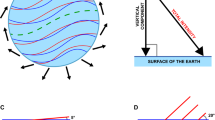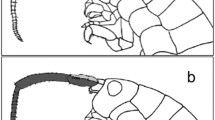Abstract
We provide evidence for the use of a magnetic compass for y-axis orientation (i.e., orientation along the shore-deep water axis) by tadpoles of the European common frog (Rana temporaria). Furthermore, our study provides evidence for a wavelength-dependent effect of light on magnetic compass orientation in amphibians. Tadpoles trained and then tested under full-spectrum light displayed magnetic compass orientation that coincided with the trained shore-deep water axes of their training tanks. Conversely, tadpoles trained under long-wavelength (≥500 nm) light and tested under full-spectrum light, and tadpoles trained under full-spectrum light and tested under long-wavelength (≥500 nm) light, exhibited a 90° shift in magnetic compass orientation relative to the trained y-axis direction. Our results are consistent with earlier studies showing that the observed 90° shift in the direction of magnetic compass orientation under long-wavelength (≥500 nm) light is due to a direct effect of light on the underlying magnetoreception mechanism. These findings also show that wavelength-dependent effects of light do not compromise the function of the magnetic compass under a wide range of natural lighting conditions, presumably due to a large asymmetry in the relatively sensitivity of antagonistic short- and long-wavelength inputs to the light-dependent magnetic compass.


Similar content being viewed by others
References
Adler K (1970) The role of extraoptic photoreceptors in amphibian rhythms and orientation: a review. J Herpetol 4(3–4):99–112
Adler K (1976) Extraocular photoreception in amphibians. Photochem Photobiol 23(4):275–298. doi:10.1111/j.1751-1097.1976.tb07250.x
Adler K, Taylor DH (1973) Extraocular perception of polarized light by orienting salamanders. J Comp Physiol 87:203–212
Auburn J, Taylor DH (1979) Polarized light perception and orientation in larval bullfrogs, Rana catesbeiana. Anim Behav 27:658–668. doi:10.1016/0003-3472(79)90003-4
Batschelet E (1981) Circular statistics in biology. Academic Press, New York
Bertolucci C, Foà A (2004) Extraocular photoreception and circadian entrainment in nonmammalian vertebrates. Chronobiol Int 21(4–5):501–519. doi:10.1081/CBI-120039813
Biskup T, Schleicher E, Okafuji A, Link G, Hitomi K, Getzoff ED, Weber S (2009) Direct observation of a photoinduced radical pair in a cryptochrome blue-light photoreceptor. Angew Chem Int Ed 48(2):404–407. doi:10.1002/anie.200803102
Deutschlander ME, Borland SC, Phillips JB (1999a) Extraocular magnetic compass in newts. Nature 400:324–325. doi:10.1038/22450
Deutschlander ME, Phillips JB, Borland SC (1999b) The case for light-dependent magnetic orientation in animals. J Exp Biol 202:891–908
Deutschlander ME, Phillips JB, Borland SC (2000) Magnetic compass orientation in the eastern red-spotted newt, Notophthalmus viridescens: rapid acquisition of the shoreward axis. Copeia 2000(2):413–419
Diego-Rasilla FJ, Phillips JB (2007) Magnetic compass orientation in larval Iberian green frogs, Pelophylax perezi. Ethology 113:474–479. doi:10.1111/j.1439-0310.2007.01334.x
Diego-Rasilla FJ, Luengo RM, Phillips JB (2010) Light-dependent magnetic compass in Iberian green frog tadpoles. Naturwissenschaften 97(12):1077–1088. doi:10.1007/s00114-010-0730-7
Dodt E, Heerd E (1962) Mode of action of pineal nerve fibers in frogs. J Neurophysiol 25:405–429
Eakin R (1961) Photoreceptors in the amphibian frontal organ. P Natl Acad Sci USA 47:1084–1088
Eakin RM, Quay WB, Westfall JA (1963) Cytological and cytochemical studies on the frontal and pineal organs of the treefrog, Hyla regilla. Z Zellforsch mik Ana 59:663–683
Eldred WD, Nolte J (1978) Pineal photoreceptors: evidence for a vertebrate visual pigment with two physiologically active states. Vis Res 18:29–32. doi:10.1016/0042-6989(78)90073-1
Ferguson DE (1967) Sun-compass orientation in anurans. In: Storm RM (ed) Animal orientation and navigation. Oregon State University Press, Corvallis, pp 21–34
Ferguson DE, Landreth HF (1966) Celestial orientation of Fowler’s toad (Bufo fowleri). Behaviour 26:105–123
Ferguson DE, Landreth HF, Turnipseed MR (1965) Astronomical orientation of the southern cricket frog, Acris gryllus. Copeia 1:58–66
Ferguson DE, Landreth HF, McKeown JP (1967) Sun compass orientation of the northern cricket frog (Acris crepitans). Anim Behav 15:45–53
Ferguson DE, McKeown JP, Bosarge OS, Landreth HF (1968) Sun-compass orientation of bull-frogs. Copeia 1968:230–235
Freake MJ, Phillips JB (2005) Light-dependent shift in bullfrog tadpole magnetic compass orientation: evidence for a common magnetoreception mechanism in anuran and urodele amphibians. Ethology 111(3):241–254. doi:10.1111/j.1439-0310.2004.01067.x
Freake MJ, Borland SC, Phillips JB (2002) Use of a magnetic compass for Y-axis orientation in larval bullfrogs, Rana catesbeiana. Copeia 2002(2):466–471
Gosner KL (1960) A simplified table for staging anuran embryos and larvae with notes on identification. Herpetologica 16:183–190
Harkey GA, Semlitsch RD (1988) Effects of temperature on growth, development, and color polymorphism in the ornate chorus frog Pseudacris ornata. Copeia 1988:1001–1007
Justis CS, Taylor DH (1976) Extraocular photoreception and compass orientation in larval bullfrogs, Rana catesbeiana. Copeia 1976:98–105
Kelly DE (1962) Pineal organs: photoreception, secretion and development. Amer Sci 50:597–625
Kelly DE, Smith SW (1964) Fine structure of the pineal organs of the adult frog, Rana Pipiens. J Cell Biol 22:653–674
Korf HW, Liesner R, Meissl H, Kirk A (1981) Pineal complex of the clawed toad, Xenopus laevis Daud: structure and function. Cell Tissue Res 216(1):113–130. doi:10.1007/bf00234548
Koyanagi M, Kawano E, Kinugawa Y, Oishi T, Shichida Y, Tamotsu S, Terakita A (2004) Bistable UV pigment in the lamprey pineal. P Natl Acad Sci USA 101(17):6687–6691. doi:10.1073/pnas.0400819101
Landreth HF, Ferguson DE (1967a) Newt orientation by sun-compass. Nature 215:516–518
Landreth HF, Ferguson DE (1967b) Newts: sun-compass orientation. Science 158(3807):1459–1461. doi:10.1126/science.158.3807.1459
Lannoo MJ (1999) Integration: nervous and sensory systems. In: McDiarmid RW, Altig R (eds) Tadpoles: the biology of anuran larvae. University of Chicago Press, Chicago, pp 149–169
Mardia KV, Jupp PE (2000) Directional Statistics. Wiley, New York
Mathis U, Schaeffel F, Howland HC (1988) Visual optics in toads (Bufo americanus). J Comp Physiol A 163(2):201–213. doi:10.1007/bf00612429
McKeown JP (1968) The ontogenetic development of Y-axis orientation in four species of anurans. Unpublished Ph.D. dissertation, Mississippi State University, Mississippi
Phillips JB (1986) Magnetic compass orientation in the Eastern red-spotted newt (Notophthalmus viridescens). J Comp Physiol A 158:103–109
Phillips JB, Borland SC (1992a) Behavioral evidence for the use of a light-dependent magnetoreception mechanism by a vertebrate. Nature 359:142–144. doi:10.1038/359142a0
Phillips JB, Borland SC (1992b) Wavelength-specific effects of light on magnetic compass orientation of the eastern red-spotted newt (Notophthalmus viridescens). Ethol Ecol Evol 4:33–42
Phillips JB, Deutschlander ME, Freake MJ, Borland SC (2001) The role of extraocular photoreceptors in newt magnetic compass orientation: evidence for parallels between light–dependent magnetoreception and polarized light detection in vertebrates. J Exp Biol 204:2543–2552
Phillips JB, Jorge PE, Muheim R (2010) Light-dependent magnetic compass orientation in amphibians and insects: candidate receptors and candidate molecular mechanisms. J R Soc Interface 7(Suppl 2):S241–S256. doi:10.1098/rsif.2009.0459.focus
Rodríguez-García L, Diego-Rasilla FJ (2006) Use of a magnetic compass for Y-axis orientation in premetamorphic newts (Triturus boscai). J Ethol 24(2):111–116. doi:10.1007/s10164-005-0169-z
Rubens SM (1945) Cube–surface coil for producing a uniform magnetic field. Rev Sci Instrum 16:243–245
Russell AP, Bauer AM, Johnson MK (2005) Migration in amphibians and reptiles: an overview of patterns and orientation mechanisms in relation to life history strategies. In: Elewa AMT (ed) Migration of organisms: climate, geography, ecology. Springer, Berlin, pp 151–203
Sivak JG, Warburg MR (1983) Changes in the optical properties of the eye during metamorphosis of an anuran, Pelobates syriacus. J Comp Physiol A 150:329–332
Stebbins RC, Cohen NW (1997) A natural history of amphibians. Princeton Univesity Press, Princenton
Taylor DH (1972) Extra-optic photoreception and compass orientation in larval and adult salamanders (Ambystoma tigrinum). Anim Behav 20:233–236
Taylor DH, Adler K (1973) Spatial orientation by salamanders using plane-polarized light. Science 181:285–287
Taylor DH, Auburn J (1978) Orientation of amphibians by linearly polarized light. In: Schmidt-Koenig K, Keeton W (eds) Animal migration, navigation and homing. Springer, Berlin, pp 334–346
Taylor DH, Ferguson DE (1970) Extraoptic celestial orientation in the southern cricket frog Acris gryllus. Science 168:390–392
Tomson OH, Ferguson DE (1972) Y-axis orientation in larvae and juveniles of three species of Ambystoma. Herpetologica 28:6–9
Ultsch GR, Bradford DF, Freda J (1999) Physiology: coping with the environment. In: McDiarmid RW, Altig R (eds) Tadpoles: the biology of anuran larvae. University of Chicago Press, Chicago, pp 189–214
Vígh B, Manzano MJ, Zádori A, Frank CL, Lukáts A, Röhlich P, Szél A, Dávid C (2002) Nonvisual photoreceptors of the deep brain, pineal organs and retina. Histol Histopathol 17:555–590
Wada S, Kawano-Yamashita E, Koyanagi M, Terakita A (2012) Expression of UV-sensitive parapinopsin in the iguana parietal eyes and its implication in UV-sensitivity in vertebrate pineal-related organs. PLoS ONE 7(6):e39003. doi:10.1371/journal.pone.0039003
Wells DK (2007) The ecology and behavior of amphibians. University of Chicago Press, Chicago
Zug JR, Vitt LJ, Caldwell JP (2001) Herpetology: an introductory biology of amphibians and reptiles, 2nd edn. Academic Press, San Diego
Acknowledgments
The Cantabria autonomous government (Dirección General de Montes y Conservación de la Naturaleza) granted the necessary permits for the study. We sincerely thank Marcos Diego-Gutiérrez for invaluable assistance during this study. Comments by Michael Painter improved the manuscript. J.P. was supported by a grant from the NSF (USA) IOS 07-48175. The experiments reported herein comply with the current laws of Spain. The authors declare that they have no conflict of interest.
Author information
Authors and Affiliations
Corresponding author
Rights and permissions
About this article
Cite this article
Diego-Rasilla, F.J., Luengo, R.M. & Phillips, J.B. Use of a light-dependent magnetic compass for y-axis orientation in European common frog (Rana temporaria) tadpoles. J Comp Physiol A 199, 619–628 (2013). https://doi.org/10.1007/s00359-013-0811-0
Received:
Revised:
Accepted:
Published:
Issue Date:
DOI: https://doi.org/10.1007/s00359-013-0811-0




